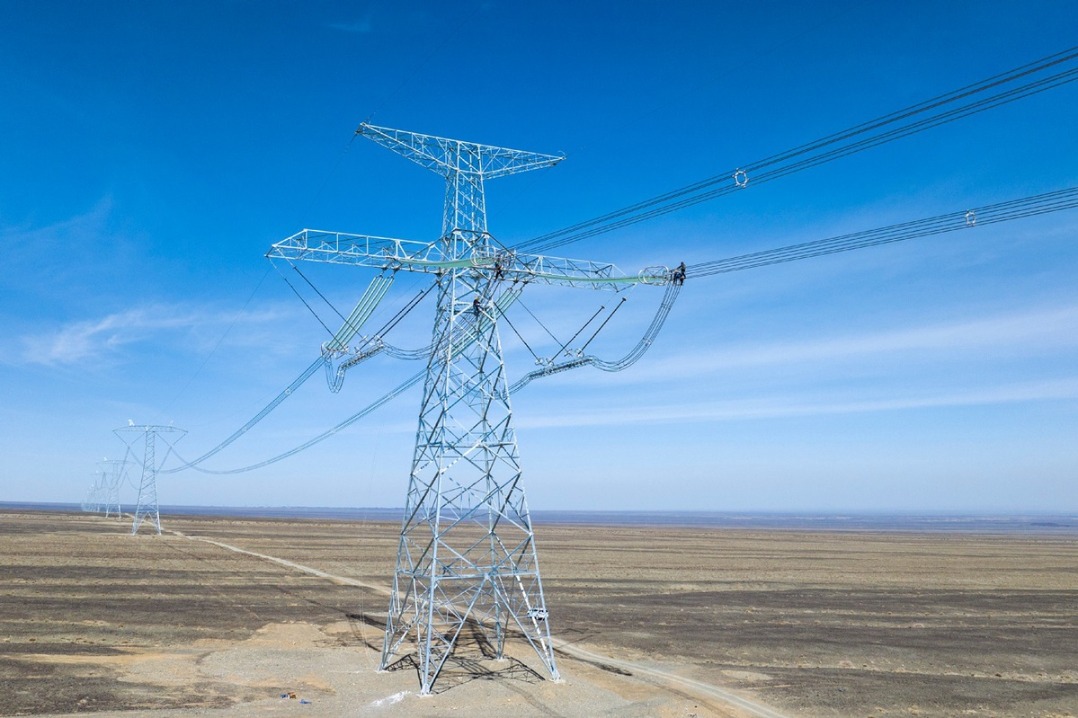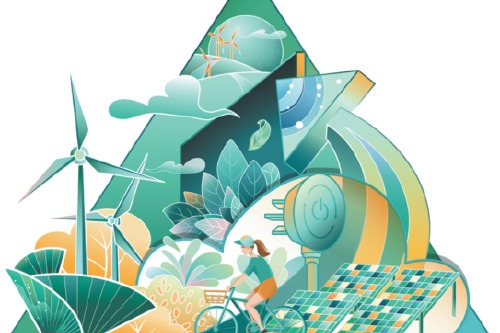Transition guide and helper
China will stay committed to promoting the construction of renewable energy systems and advancing global climate governance


On April 23, in a speech via video link at the Leaders Meeting on Climate and the Just Transition, President Xi Jinping said: "Since I announced China's goals for carbon peaking and carbon neutrality five years ago, we have built the world's largest and fastest-growing renewable energy system as well as the largest and most complete new energy industrial chain."
In this sense, China remains committed to promoting international cooperation and advancing global climate governance.
By the end of 2024, the cumulative installed capacity of China's renewable energy had reached 1.889 billion kilowatts, accounting for 56 percent of the country's total. Specifically, wind and solar power installations had reached 521 million kW and 887 million kW respectively, representing approximately 46 percent and 48 percent of the global totals.
China's renewable energy generation, including hydro power, reached 3.46 trillion kilowatt-hours in 2024, accounting for about 35 percent of the total electricity generated. The penetration rate of new energy vehicles surged from 5.4 percent in 2020 to 47.6 percent in 2024, while the number of charging infrastructure facilities for NEVs surged from 1.681 million to 12.818 million, gradually making NEVs the mainstream in new vehicle sales.
China has achieved basic self-sufficiency in core segments of the new energy supply chain, providing the world with high-quality and cost-effective new energy products. All top 10 photovoltaic module suppliers by volume in 2024 were Chinese companies, supplying 70 percent of global PV components. Six of the world's top 10 wind turbine manufacturers are Chinese companies, supplying nearly 60 percent of installed capacity worldwide. Similarly, six Chinese companies were listed in the top 10 global power battery manufacturers in 2024, while Chinese NEVs command over 70 percent of global market share. In ecological and environmental protection, China has become the largest contributor to land greening efforts in the world and the main engine of global ecological progress.
China stepped up its greening efforts last year with 4.45 million hectares of forest planted. In 2024, the country also treated 2.78 million hectares of sandy and stony land. The completion of a green barrier around the Taklimakan Desert highlights China's commitment to combating desertification and sets a global example for desertification control. This is a huge achievement in human history.
However, international cooperation among countries has been disrupted, potentially impeding climate action.
The "reciprocal tariffs" imposed by the United States in April have triggered deep turmoil in global trade. In the guise of "fair trade", the US has imposed tariffs globally. The move violates the principle of comparative advantage and severely obstructs global climate governance through the following three impacts.
To start with, past US policies were aimed at forcing companies to shift manufacturing to neighboring countries of the US, such as Mexico, through nearshoring under regional trade frameworks such as the US-Mexico-Canada Agreement. However, these regions rely heavily on fossil fuels. Such production relocation will significantly increase product life cycle emissions and reverse the global decarbonization progress.
Using tariffs as a weapon for geopolitical purposes, the US is trying to force its trading partners to "pick sides". In the future, the US may continue to leverage its dominance in international rules to create hidden barriers, employing political coercion, rules-based obstacles and aid conditionality to pressure certain nations into abandoning Chinese new energy products and supply chains in favor of high-cost alternatives.
This would elevate the cost of global energy transition and slow it down. From the perspective of addressing climate change, suppressing China's low-cost new energy exports will create obstacles in responding to climate change and essentially squeeze humanity's living space in the long term.
A decline in global trade induced by the US tariffs will undercut developing countries' export incomes. According to estimates, the volume of global merchandise trade is expected to decline in 2025 under current tariff conditions, nearly 3 percentage points lower than the previous forecast based on a "low tariff" scenario, according to the World Trade Organization.
A decline in developing nations' export earnings will pressure their climate budgets. The fiscal budget originally allocated for the construction of renewable energy projects could be diverted toward maintaining fundamental trade balances. Shrinking export revenues may also possibly compel developing countries to relax environmental regulations on traditional energy sectors in order to sustain economic growth, potentially regressing to high-carbon development pathways.
Confronting these challenges, China will stay committed to promoting the construction of renewable energy systems, completing the clean energy transition, and advancing global climate governance.
Globalization represents an irresistible historical tide that no unilateral or protectionist measures can stem. The trade barriers imposed by the US under the guise of "reciprocal tariffs" are, in essence, a shortsighted move running counter to this globalizing momentum. China should take the following measures to build a global climate governance system through open cooperation and support green transition globally.
First, China should deepen collaboration with more nations to accelerate their energy transitions.
Capitalizing on its established industrial chains and technological strengths in PV and wind power sectors, China could facilitate the cross-border deployment of clean energy manufacturing bases. This involves simultaneously developing PV and wind projects with complementary storage infrastructure while enhancing project viability through resource exchanges, technology equity participation, and joint operation frameworks to create a win-win situation. Such initiatives will stimulate economic growth and create local employment opportunities, simultaneously elevating renewable energy shares in their national and local grids. This can address the host countries' fossil fuel dependency, thus achieving the dual objectives of industrial capacity transfer and sustainable decarbonization.
Second, China should strengthen multilateral coordination mechanisms and collaborative networks to build an open, inclusive global climate governance framework.
Leveraging multilateral platforms such as the United Nations Climate Change Conference and the WTO, China should institutionalize regular dialogues aligning trade and climate policies and deepen cooperation with strategic partners to jointly counter the politicization of tariff instruments through unilateral actions.
The year 2025 is a pivotal milestone in China-EU relations, as it marks the 50th anniversary of the establishment of diplomatic relations between China and the EU's forerunner — the European Economic Community. As two major global economies, both parties should harness green cooperation as a strategic linchpin to steer the world toward a low-carbon, sustainable future.
Beyond accelerating mutual recognition of green technology standards, China and Europe should make joint efforts to remove market access barriers for third-party nations utilizing Chinese supply chains to enter European markets. By creating diversified market access pathways, this approach would undermine the US' coercive leverage to ensure energy transition affordability for emerging economies.
Third, China should pioneer innovative international climate finance mechanisms to resolve the fiscal constraints on the low-carbon transition of developing countries.
A cross-border guarantee facility jointly established by Chinese and European policy banks could provide credit enhancements for developing countries' renewable energy projects.
Financial instrument innovation, coupled with support from Chinese and European markets, will not only alleviate tariff-induced capital chain strains, but also preserve policy flexibility for developing nations. By structurally blocking regression to carbon-intensive pathways through monetary channels, such mechanisms would strengthen the resilience of global climate governance.

The author is a chair professor at the School of Management and director of the China Institute for Studies in Energy Policy at Xiamen University. The author contributed this article to China Watch, a think tank powered by China Daily. The views do not necessarily reflect those of China Daily.
Contact the editor at editor@chinawatch.cn.


































